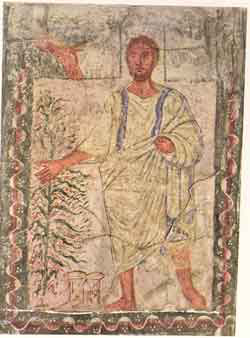JACOB WHO? WILL THE REAL JACOB STAND UP
In the course of his return home (Genesis 31 – 33), contentious Jacob faces three adversaries: Laban, his equally crafty father-in-law; the mystery man/angel; and Esau, his duped twin.
But confronting these "others," he must also confront himself. Visual artists delight in the ambiguities and foibles of human interaction. How do they convey the complexity of Jacob's growing terror and his emerging clarity?
When Jacob starts out (Genesis 28) he is self-involved, cocky, a wheeler-dealer.
And Jacob vowed a vow, saying: 'If God will be with me, and
will keep me in this way that I go, and will give me bread to
eat, and raiment to put on, so that I come back to my father's
house in peace, then shall the LORD be my God, and
this stone, which I have set up for a pillar, shall be God's
house; and of all that Thou shalt give me I will surely give
the tenth unto Thee.'
Notice the emphasis above on the first person (I, me, my, etc.) and the conniving response to God's promise of support, "God, if you do all this for me, you will get 10% of all my profits and I will join your congregation."
Twenty years later (Genesis 32), humbled by life Jacob declares himself unworthy of God's bounty.
Then Jacob was greatly afraid and was distressed….
And Jacob said:
I am not worthy of all the mercies, and of all the truth, which
Thou hast shown unto Thy servant; for with my staff I passed over
this Jordan; and now I am become two camps.
Deliver me, I pray Thee, from the hand of my brother, from
the hand of Esau; for I fear him, lest he come and smite me, the
mother with the children.
Jacob freely admits his fear, not only for himself, but beyond himself, for his wives and children. The chastened manipulator repeats God's promise but this time he does not dare broker a deal.
Jacob's vulnerability and staff
The biblical text stresses the reversal of Jacob's fortune from that of a lone ragged fugitive to tribal opulence. However, two seventeenth century Dutch artists show Jacob's vulnerability through the medium of his staff.
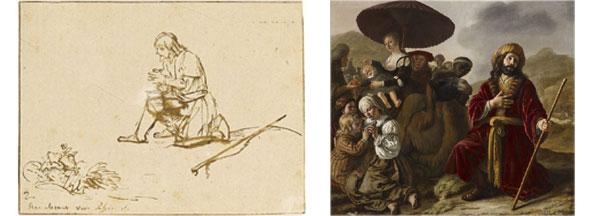
Rembrandt portrays him penitent, utterly alone but for his staff. Divine diagonal light points to his bent knee. In Jan Victors' painting (on the right) Jacob, about to meet Esau, although surrounded by devoted family, still clutches his staff for support. "Thy rod and thy staff they comfort me" (Psalm 23:4)
Confrontation with a Manangel
How does this vulnerability translate in the nocturnal confrontation with "the other"?
That same night he arose, and taking his two wives, his two
maidservants, and his eleven children, he crossed the ford of the
Jabbok. After taking them across the stream, he sent across all his
possessions. Jacob was left alone. And a man wrestled with him
until the break of day. When he saw that he could not prevail
against him, he wrenched Jacob's hip at its socket, so that the
socket of his hip was strained as he wrestled with him. The he said,
Let me go, for dawn is about to break. But he answered, I will not
let you go, unless you bless me. Said the other, What is your name?
He replied, Jacob. Said he, Your name shall no longer be Jacob, but
Israel, for you have striven with beings, divine and human, and have
prevailed. Jacob asked, Pray tell me your name. But he said, You
must not ask my name! And he took leave of him there.
Genesis 32: 23-30 (NJPS)
The deliberate ambiguities of the text reflect Jacob's inner turmoil.
• Did he cross with his people or did he cross them and remain alone on the far bank?
• Who could not prevail?
• Who is this "man"?
• What is the nature of the injury?
Everything he ran away from is now attacking him.
Jacob's return and reconciliation with Esau (Gen 32-33) closes the awakening phase of the Jacob cycle. Each element of the return parallels an aspect of the 'going out'.
1. Crossing the Jabbok returns him to the promised land from the refuge of the diaspora, movement reflected here in the Vienna Genesis (see more below).
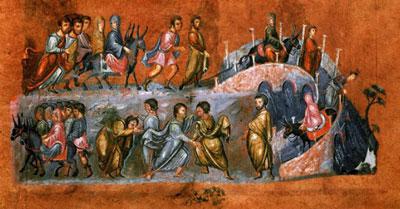
early 6th century
2. The name itself, Jabbok, echoes linguistically the dual nature of the encounter: hostile from avak, raising the dust
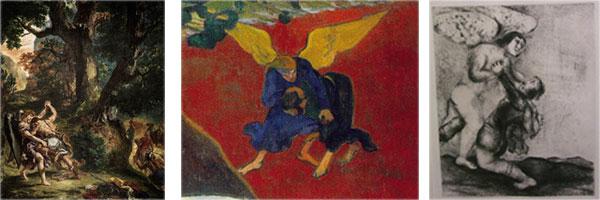
1854 – 61 1888
and nurturing from habek, embrace, recalling the tormented relationship with the land, with God, with the nations, with family.
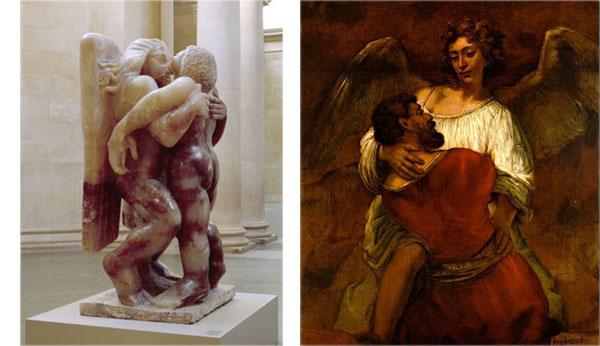
This intensity reflects the stormy environment of Jacob's nuclear family, manipulative divided parental love, and sibling jealousy, deceit and rage (Genesis 27-28)
3. The life-threatening exposure to the demonic/divine starkly contrasts with the charming invitation to encounter the awesome divine at the ladder scene.
At the outset Jacob didn't realize 'God was in this place'. He still has no clue when he asks for the "manangel's" name, but he knows he needs the blessing (yet another one). He will be wounded, but will escape with his life.
The climax of the nocturnal encounter in which Jacob's identity rings clear can be seen in the 6th century Vienna Genesis.
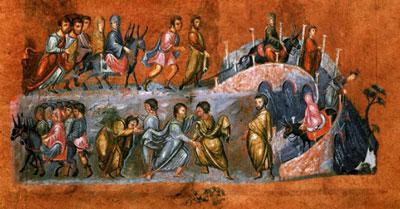
Jacob and the blue manangel appear twice, at the center of the lower register. On the right, the two struggle; on the left the angel blesses his "humbled yet victorious" combatant. The textual dialog, unseen in the painting, takes place between the two paired figures. Jacob has refused to release the "manangel" until the latter blesses him. The "manangel" asks, what is your name? "And he said, Jacob". This Q&A echoes back to Jacob's dinner meeting with his father from whom he sought the blessing that belonged to his elder twin. The old blind Isaac was confused by the dissonance between the voice that didn't belong to the hairy hands "Are you really Esau". Twice Jacob lied to his father and concealed his real identity. (Genesis 27:18-22).
The Vienna Genesis, by illuminating the "manangel"s blessing, confirms Jacob's new clarity, "Yes, I no longer pretend to be someone else; I am Jacob," at which point the divine figure proclaims that he has earned a name change, "You are no longer the devious Jacob, you are Yisrael, isra-el a man who has confronted divine power and overcome."
Various readings of the encounter with Esau
The meeting with Esau in Genesis 33 proceeds in calculated steps stalling, delaying and mounting tension:
– Jacob sights Esau with his 400 armed men
– Jacob once again divides his camp, ranking his clan by sub-units of
attachment
– And then passing before them bows seven times as he nears Esau
Finally in an accelerating sequence of stills:
And Esau ran to meet him, and embraced him, and fell on his
neck, and kissed him; and they wept. (Genesis 33:4)
וַיָּ֨רָץ עֵשָׂ֤ו לִקְרָאתוֹ֙ וַֽיְחַבְּקֵ֔הוּ וַיִּפֹּ֥ל עַל־צַוָּארָ֖ו וַׄיִּׄשָּׁׄקֵ֑ׄהׄוּׄ וַיִּבְכּֽוּ׃
After all the anger and pain, the two brothers are actually reconciled—or are they? We may be reminded of the hopeful anxiety that preceded President Sadat's first visit to Israel.
Indicating their disbelief, the Masoretes, scribes who preserved the accuracy of the Hebrew text of the Bible, marked וישקהו (and he kissed him) with a series of dots above the letters: Esau kissed Jacob?! They provide a mysterious visual cue, like a series of exclamation points. Rabbinic opinion was divided on the meaning of the dots, adding cynicism and grotesque humor.
Our selection of artwork on this scene portrays the meeting variously as abject contrition, suspicious groping, a tentative hug and finally a loving embrace.
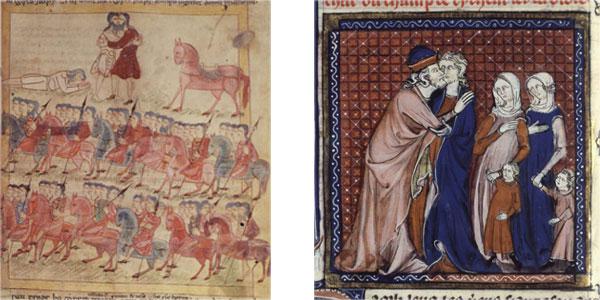

Reconciliation, 1999 Yaakov Steinhardt, Jacob and Esau, 1950
This sequence can be seen as a therapeutic process, applicable today as much as in the Bible. Throughout Jewish history, Esau has represented the hostile other. However, the doubtful nature of the kiss is just as much a product of Jacob's manipulation and guilt as of Esau's justified bitterness. Both sides of this tension are the outcome of human and divine favoritism. Thus the renewed meeting of Jacob and Esau can be an opportunity for us to reevaluate our attitude toward others, and brothers, on many levels.
Their encounter contains a stunning statement by Yis-ra-el 'the one who sees God' (no longer Yaakov 'the deceiver'):
I see your face as though I have seen the face of God
Genesis 33:10
Is he saying: I see the divine in the human face? If so, Jacob/Israel, the sleeper, is now awake.
For additional images on this subject see TALI Visual Midrash



